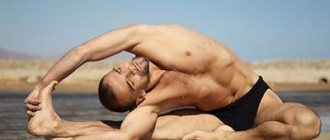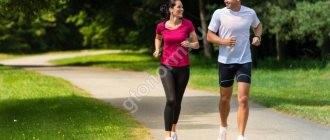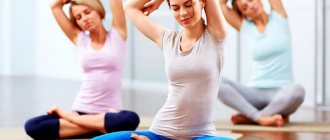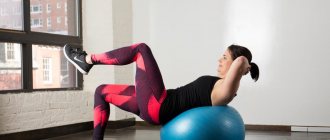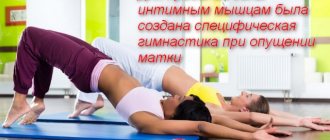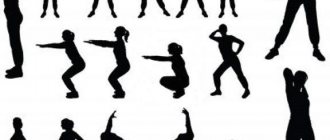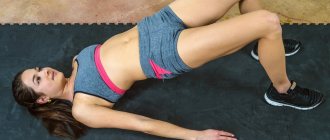- KtoNaNovenkogo
- FAQ
- Are you here
May 29, 2019
- What is stretching
- Basic principles of exercises
- What is the benefit
- Types of stretching
- Exercises for beginners (video)
- Conclusion
Hello, dear readers of the KtoNaNovenkogo.ru blog. In the world of sports and fitness, you can often come across the mysterious word “stretching”.
It is recommended to start and end workouts with it, to be included in the daily program for general physical development, and the benefits of this activity for the body are legendary.
What is stretching, what are its features and what impact does it have on human health, we will find out further.
What is stretching and what are its features?
Stretching is a type of fitness consisting of sets of exercises aimed at stretching muscles, that is, stretching, through static or dynamic impact.
Each muscle in our body needs to perform certain functions, and with an active lifestyle, none of them remains unused. Some muscles experience excessive stress, compensating for the shortcomings of weak ones, and take on a lot of work. Other muscles, on the contrary, are atonic, which are not included in the process of life activity at all. And stretching in this situation helps in both cases. If muscles are too tight and inelastic, it is difficult for them to perform their functions, recover and grow. Stretching training can relax such muscles and make them more elastic. And if the muscles are weak, again, stretching helps to strengthen and tone them.
A huge advantage of stretching is that the load does not overload the cardiovascular system.
Thus, you can perform a stretching routine in case of cardiovascular diseases, and also, without overloading the heart, you can do stretching after strength training, helping the muscles recover faster and increase their elasticity.
Contraindications for carrying out
The presented classes have the following contraindications for practice:
- It is forbidden to resort to stretching during an exacerbation of joint diseases;
- you cannot resort to muscle stretching exercises if there are serious vein pathologies - the presence of blood clots, varicose veins;
- there are disorders in the functioning of the heart and circulatory system;
- it is forbidden to resort to loads if there are pathologies of the spine;
- loads are prohibited when ligaments are injured;
- It is not recommended to resort to stretching immediately after removing the plaster.
Always consult a doctor before exercising. If a person has the above contraindications, training should be postponed or abandoned altogether in favor of another sport.
Types of stretching
- Static is a type of stretching in which the exercise is held in a certain position, at the peak of extension, for a minimum of 30 seconds, a maximum of 3 minutes.
- Passive - this type of stretching does not involve stretching the muscles on your own, but loading with the help of a partner, for example a trainer, who increases the stretching using pressure.
- Dynamic - in this type of stretching, springy movements are performed, focusing on the peak of muscle stretching; they can be smooth and slow, as well as fast and quite sharp. This also includes exercises that are performed dynamically: various combinations of exercises.
- Ballistic – with this type you can test the maximum capabilities of your stretching. Remembering the popular school exercise: Sitting on the buttocks with straight legs in front of us, springing forward with emphasis, we stretch our fingers towards our feet and at the end of the movement we pause, trying to reach our fingers as far behind our feet as possible.
- Isolated - in this type of stretching exercises, only one muscle group is stretched isolated from the others.
- Isometric - in this form, muscle relaxation and contraction alternate. Thus, first, complete relaxation is performed and the desire for maximum extension is performed, then a load is performed with resistance, in which the muscle tends to seem to jump out of this position and tenses. Then again alternates with stretching.
Muscle stretching exercises
Now, step by step, with pictures, I will list what exercises to do for stretching. We remember and repeat, or add it to our wall so as not to lose it (the buttons for adding an article to social networks are located below the article). The exercises that I will describe will be quite sufficient for normal stretching - there is no point in stretching every small muscle, it is enough to stretch all the large muscle groups. I will be logical, so I will describe stretching exercises from top to bottom, from the neck to the calves.
I recommend that after training you stretch the muscles that were worked during this training. Why stretch our legs if we pressed the barbell on the workout?
The pictures with which I will supplement each exercise will help you better understand how to do stretching exercises correctly. Okay, enough of the foreplay, let's get down to business.
The benefits and harms of stretching
Pros of stretching:
- Exercises can be performed even if you have cardiovascular diseases.
- Stretching is suitable for exercise at any age, regardless of gender and physical fitness.
- Strengthens muscles without overloading the heart.
- Increases joint flexibility and muscle elasticity.
- Relaxes the nervous system.
- Increases blood circulation.
- Helps to lose weight due to sufficient oxygen supply to the muscles.
- Accelerates muscle recovery during strength training, which helps accelerate muscle growth.
- Improves posture.
Minuses:
- With incorrect technique and poor flexibility of the ligamentous apparatus, there is a risk of injury in the form of sprains or tissue ruptures.
- Injuries caused by sudden movements are subject to long rehabilitation, and muscles and ligaments take a long time to return to normal.
Benefits of classes
Stretch training has the following positive aspects:
- the mobility of joints and muscles increases significantly;
- the circulatory system is normalized;
- the outflow of lymph is noticeably improved - it turns out that swelling of the extremities is prevented;
- correct posture is formed - in accordance with physiology;
- pain in the spine decreases;
- Stress and depression are prevented;
- it turns out to prevent bad mood in women during premenstrual syndrome;
- mood and sleep improve noticeably.
Classes must be conducted in accordance with recommendations and rules so as not to provoke an exacerbation of existing pathologies. Correctly performed exercises mean flexibility and maximum efficiency from stretching training.
Video
A set of stretching exercises for beginners
As with any form of fitness and sport, it is important to start your workout with a warm-up. Like the stretching itself, warm-up should be smooth and soft, without any sudden movements, fast and strong springs. Perform each exercise for at least 30 seconds. In those exercises where you feel comfortable and the stretching is even pleasant, stay in the position for up to three minutes, again, without bringing the muscles to acute pain.
Warm-up
Start your workout with deep breathing, which you must maintain throughout the entire workout: inhale through your nose, exhale through your mouth. As you exhale, try to relax as much as possible and stay at the peak of your extension.
Exercise No. 1
Stretch your arms out to your sides, taking a deep breath. Reach your palms and shoulders toward the ceiling as much as possible. As you exhale, lower your arms down. Repeat several breathing cycles.
Exercise No. 2
Perform gentle bends to the sides, stretching your torso on the sides in one direction and the other.
Exercise #3
Perform turns and tilts with your head, stretching your neck.
Exercise #4
Curl down, relaxing each part of the spine. Lower your body into a relaxed position, standing on bent knees, relax your spine. Straighten back up, performing the movements smoothly, and so on several times.
Exercise #5
Perform circular movements with your knee on each side, warming up the joint.
Exercise #6
Roll from toe to heel.
Exercise No. 7
Bend down toward your hips, stretching the back of your body.
Main part
Exercise No. 1
Place your feet wide with your toes pointing out to the sides. With a straight spine, bend your body forward with your arms, keeping a straight line parallel to the floor. Try to stretch forward as much as possible without rounding your back. Hold the position.
Exercise No. 2
From a straight spine, bend down the center between your thighs, relax and feel an intense stretch in the back of your body. Maintain this position for a while.
Exercise #3
In the same position of the feet, place one palm on the floor in the center, raise the other hand up, forming a straight line. Feel the twisting of the thoracic region, look up. Don't round your back. Same thing on the other side.
Exercise #4
Stay bent over and clasp the shin of your right leg with both hands, using your arms to pull your torso as close to your thigh as possible, hold the position. Then change to the other side.
Exercise #5
From the position of your feet wide, palms on the floor in the center, begin to turn to the right, stepping over your palms, gradually moving into a half-split pose: right knee at an angle of 90 degrees, left leg on the toe, straight at the knee. Hands on the sides of the foot rest on the floor with straight elbows. Try to gradually lower your pelvis as low as possible to the floor, without springs. Hold the pose for a while.
Exercise #6
Begin to smoothly straighten your right knee, exhaling, trying to relax the muscles, and as you inhale, return smoothly to the floor splits - a dynamic technique. Perform the extension gently for 30 seconds and at the end, pause at the top point, maintaining maximum extension.
After this, step with your palms in the opposite direction and, moving into the floor splits on your left leg, repeat the same exercises.
Exercise No. 7
From the semi-split position, rotate your body, walking your hands to the right towards the inner thigh. Bend your left leg at a right angle, and keep your right leg straight, placing it on your heel. Stretch your arms forward as far as possible, stretching your body behind your palms, relax. Then change to your right leg, stretch forward and hold for the same amount of time.
Exercise #8
Perform dynamic rolls from side to side, touching your palms to the floor. Smoothly shift your body weight from one leg to the other. After completing the movement, bring your feet together and slowly rise up.
Hitch
At the end of the complex, perform several relaxing and stretching exercises.
Belly to thigh folds
Feet together, then legs wide
Stretch your back and arm muscles
Perform the cool-down smoothly, thus trying to relax the muscles, and not re-load them.
Basic complex
The basic stretching complex includes the following exercises:
- Stand up straight and squat down a little. Raise one hand up, as if reaching for the ceiling, and keep the other below. Then change the position to a mirror one and repeat the movement 10 times on each hand.
- Sitting on the floor, spread your legs wide apart. Place your hands behind your head and tilt your body towards each leg in turn, trying to touch your forehead to your knee.
- Get on all fours and “fly” by stretching your leg back and the opposite arm forward. Change position and repeat it up to 10 times.
- In a lying position on your back, you need to pull your legs to your chest, clasp them with your arms and freeze for a few seconds - 20 seconds is enough. Stretch your legs and repeat the stretching exercise 10 times.
- Lie on your side with your knees bent, creating a right angle. Next, you need to stretch your arms forward and turn your body with your arms in the opposite direction, while leaving your hips on the floor. In this position, it is necessary to reach the floor on the opposite side with the back of your hand.
The presented stretching exercises are recommended for use during pregnancy, unless there are contraindications to any exercise.
It is only recommended to consult a doctor about the types of stretching and acceptable exercises, since some movements are prohibited. For example, bending over can cause disturbances in the development of the fetus due to a lack of oxygen supply.
Video
Classes can improve flexibility, reduce pain when putting stress on the back (especially in the presence of certain pathologies), and also improve overall well-being. It is easy to carry out training at home, allocating only 20 minutes of time - during this period you can complete a basic stretching course. You can learn more about the specifics of the sport from the video.
Is it possible to lose weight from stretching?
No matter how strange it may be, stretching really helps to lose weight if you do the complex correctly, regularly, and for at least an hour. The load on muscle fibers during traction burns subcutaneous fat due to the supply of oxygen to the tissue. Therefore, by stretching, you can lose no less in volume than with cardio training. Of course, you should pay attention to nutrition. A high-calorie diet will ruin all your efforts.
Shoulder stretches
Press your elbow to your shoulder
Muscles stretched: posterior deltoid, middle trapezius, triceps, lats.
Performing the exercise: In a standing position, stretch one arm across the chest (for example, the right one). We place the second hand (in our example it is the left hand) slightly above the right elbow and gently pull the hand towards us parallel to ourselves, pressing it to the chest. Above the elbow you can grasp it with both the palm and the back of the wrist. At the point of static tension, the inside of the right elbow is pressed against the left shoulder. We pulled one delta, change hands and pull the other.
To strengthen the exercise, you can bend the arm you are pulling at the elbow joint, moving your wrist behind your back.
Pull your elbow behind your back
Muscles stretched: middle deltoid, posterior deltoid, coracobrachialis.
Performing the exercise: In a standing position, place your hands behind your back from below. Both arms are bent at the elbow joint, the only difference is that one hand is the leading one, and the other is the driven one (one pulls, the other pulls). We take the palm of the leading hand by the forearm of the driven one and pull it onto the leading hand... Stop, I’m somehow confused myself. It's better to use right-left examples.
With our left hand we take the forearm of our right hand and pull it (right hand) to the left and slightly up. At the point when you feel tension in the middle fascicle of the deltoid muscle (in fact, a stretch point), we pause for the required time, after which we change hands.
Exercise Sitting
Muscles stretched: posterior and middle deltoids, trapezius, triceps, slightly latissimus and serratus.
Performing the exercise: We take a semi-squat position in front of a door hatch, wall bars or any other vertical stand. As an example, let’s stretch the muscles of the right deltoid again (I see something is pulling me to the right
). We stand in front of the vertical stand so that the shoulder is approximately at the same horizontal level with the vertical support (bluntly opposite).
We take the stand with our right hand at shoulder level and squat a little lower. During a squat, the body lowers down, but the hand on the support remains in one place, due to which static tension is created in the stretched muscle. In a position where the maximum stretching of the posterior and middle deltoid bundles is felt, we freeze and stretch statically for the required time. Then we change hands.
